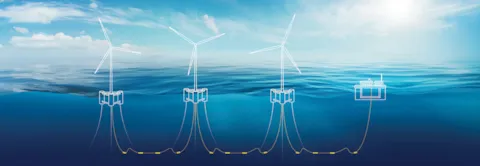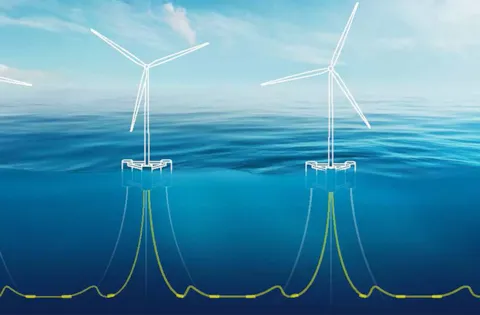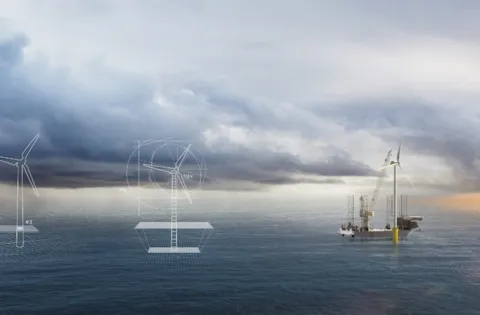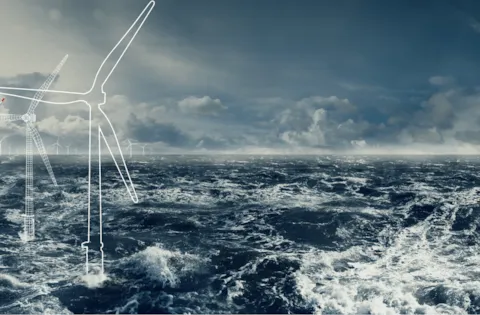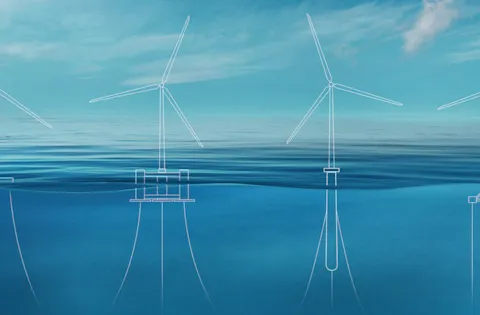of experience in managing offshore risks
involved in floating offshore wind
of offshore wind farms are certified by us
Floating offshore wind is opening new possibilities for wind power locations and will play a critical role in the transition to a cleaner energy supply. Following first successful prototypes and demonstration projects, floating offshore wind is now taking the first steps in commercialization.
As per DNV's 2024 Energy Transition Outlook (ETO), floating offshore wind capacity is projected to almost 217 GW by 2050. The levelized cost of energy (LCoE) for fixed offshore wind will be around USD 67/MWh and floating offshore at approximately USD 96/MWh, a difference of only 45%. These cost reductions will be driven by volume increases and the advantages of experiential learning.
Faced with challenges coming from unknown territory, many new concept designs and market players, the industry needs reassurance that all possible steps have been taken to minimize risks and maximize the chances of a successful project. DNV is the trusted voice to scale floating offshore wind with confidence.
Why DNV?
Expertise and trust.
DNV enables floating offshore wind commercialization by providing expertise and trust to develop safe, reliable and cost competitive projects. With our industry standards, digital tools, global presence and 160 years' experience in managing risks of offshore technologies we provide stakeholders with the needed confidence to implement the technology around the world.
Explore our floating offshore wind services
Customers and cases
DNV concludes Phase 1 of joint industry project to optimize design of floating substations
The collaborative industry effort has brought together 38 participating companies to tackle the distinctive challenges associated with floating offshore substations.
DNV provides technology qualification services for aerodyn’s new floating offshore wind design
Innovative concept allows for a rated power of 15 MW.
DNV certifies Naval Energies’ floater design basis for floating wind farm and design methods
DNV’s comprehensive certification delivers maximum floating offshore wind stakeholder confidence
DNV provides technical and market advice to Tokyo Gas on USD 22 million investment in Principle Power floating wind technology
Technical due diligence supports draws on DNV global leadership in floating wind technology.
DNV supports Equinor with verification study for Hywind Tampen floating wind farm
The introduction of floating offshore wind could cut emissions from the oil fields by more than 200,000 tonnes per year.
DNV successfully completed technical due diligence for 25 MW Windfloat Atlantic floating wind project
Technical Due Diligence helped secure EUR 60 million from the European Investment Bank to become world’s first project-financed floating wind farm
DNV launches revised design standard and new certification guideline for floating wind turbines
The documents can be applied for the design and certification of floating wind farms, floating wind turbines or their components.
DNV provides concept certification of Fred. Olsen 1848’s floating wind turbine, BRUNEL
DNV has provided Fred. Olsen 1848 with a Statement of Feasibility (similar to an Approval in Principle) for their floating wind turbine concept, BRUNEL.
DNV awards Odfjell Oceanwind AiP for new Deepsea Semi™ floating offshore wind foundation
DNV has awarded Odfjell Oceanwind an Approval in Principle (AiP) for their new Deepsea Semi™ floating wind foundation design. The Deepsea Semi™ floating wind foundation design has been developed for use in floating wind farms and for off-grid applications including temporary electrification of oil and gas installations in harsh environments.
DNV provides certification services for Hexicon’s floating wind demonstrator project TwinWay
The intention of the TwinWay project is to show proof of concept for Hexicon´s floating wind foundation TwinWind.
